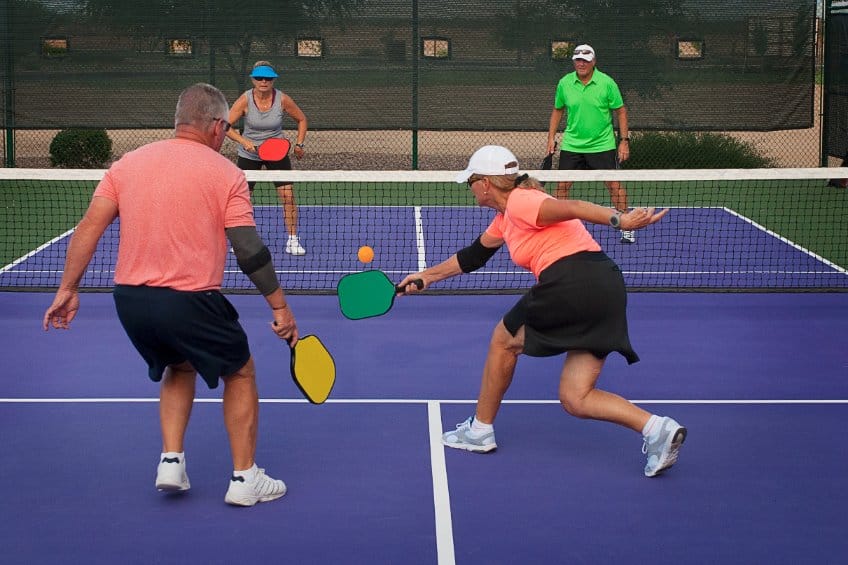By Kathy Driscoll —
Texas native and veteran water polo player Mark Braly understands the benefits of competitive sports.
He told The New York Times recently that he had always wanted to be athletic during his younger years, but it wasn’t until Mark took up water polo that he felt like a real athlete. “I love that it’s a rough game. You never know what’s going to happen next, and that encourages me to keep playing,” he said.
Keeping on is what he does. Braly didn’t start playing water polo until he was 76. That was ten years ago.
So, at what age do competitive sports have to end? There is no magic answer, experts say. Little can beat the thrill and camaraderie with playing competitive sports. “Growing up, I wanted to be athletic and wasn’t,” Braly said. “Water polo gives me a feeling that I can do sports even though I’m not good at them. And I’ve made wonderful friends.”
For some seniors, the only sports that truly fit the bill are competitive ones. Non-competitive activities such as walking, running, swimming, cross-country skiing, and yoga might be great workouts, but they don’t provide the adrenaline rush and satisfaction as competitive sports do.
Unfortunately, there’s a potential downside to breaking out a competitive sweat. While it’s important to keep the competitive urge going, older adults face a high risk of injuries. Not surprisingly, the more aggressive team sports that were so appealing in early years can pose a higher risk of injury at older ages, the info site 50 Plus World warns.
These risks may seem obvious, but that won’t stop older Americans from firing up their competitive juices.
One competitive sport to benefit from this interest among older adults is pickleball. It is extremely competitive but easier to learn than tennis. Pickleball is a hybrid between badminton and tennis and played on a smaller court and at a slower pace than tennis. It’s little wonder then that half of all pickleball players (those who play eight or more times a year) are now 55 or older, the USA Pickleball Association reports.
Beyond this, it is a good workout as well. A study by Western Colorado University found that “picklers” burned 354 calories per hour and had an average heart rate of 109 beats per minute, which is in line with moderate-intensity workouts such as hiking, yoga and water aerobics.
“It’s great for cardio, and it’s an intensely strategic game,” Tampa resident Alan Weinberger, 62, told the New York Post. “I had a stressful and successful career, so it’s a slight substitution. It hits all the chords for me.”
But as pickleball’s popularity has increased, so have related injuries among players over 55—especially among those who play several hours per day.
“Five years ago, pickleball wasn’t even something on the radar, but now injuries from it are common in that over 55, over 60 population, explained Dr. Samir Mehta, chief of orthopedic trauma and fracture care at Penn Medicine in Philadelphia. Mehta specifically cited “overuse injuries” like tendonitis, arthritis, muscle contusions and sprains, and wrist or elbow fractures that require surgery.
“It’s an older population that tends to have osteoporosis or osteopenia, and that feeds into the severity of an injury if you have a fall,” he said.
But experts note that pickleball doesn’t have to be a no go for older players. They need to play a little safer. It means adding dynamic stretching, warmups, balance and stability exercises into their regular routines. Mix in some cross-training and Pilates. It is essential that they listen to their bodies, becoming aware of minor aches and pains before they get worse.
Besides, pickleball is only one option for older adults in competitive sports. There is also age-appropriate competitive tennis, where the benefits exist. “The benefits include: higher aerobic capacities, lower resting heart rate and blood pressure responses, improved metabolic function, maintained or improved skeletal integrity, improved reaction time and decreased stress reactivity,” the University of North Carolina researchers recently reported.
“You’ll burn more calories playing three hours of tennis per week than you will be doing three hours of light weightlifting, bowling or golfing,” Dr. Gordon Blackburn, a physiologist, told AZCentral.com.
Then there’s always golf, a sport long associated with retirement years. For those with some health challenges, such as arthritis, golf builds flexibility in muscles and joints. “It’s a sport of technique, not brute strength,” AZCentral.com reported. “Even casual golfers who play a couple of days a week could find themselves walking anywhere from four to eight miles.”
And don’t forget bowling; it’s an underrated competitive sport. Bowlers develop balance and strength while swinging a ball ranging from 9 to 16 pounds. It can burn an estimated 250 calories per hour. “Seniors with a wide range of fitness can benefit from this full-body exercise benefit, from those who like to stroll along the approach to knock over a few bowling pins to those who want to hurl power strikes,” bowling blogger William Hunt claims.
“Seniors have concerns about aches and pains, loss of flexibility and strength and even falling and breaking something. These are real,” he wrote. “You need to move. Circulate that blood. You also want to keep your strength, mobility and balance. Bowling to the rescue. The oldest recorded bowler was 105 years old, and there are many current bowlers in their 80s and 90s.”
The bottom line: it’s okay to break a competitive sweat at 50, 60, 70 or beyond.












